Interview with Craig Whittington-Jones about the African Grass Owl
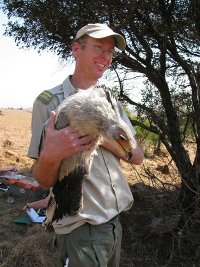
Craig was born and raised Cape Town. He was an undergrad and PhD student (Zoology) at Rhodes University in Grahamstown.
Since 2000 he has been employed as ornithologist (and herpetologist of-and-on) by Gauteng Nature Conservation.
Although not primarily a raptor biologist, he has however worked quite extensively with the EWT’s Bird of Prey Programme/
Project (and before that with the EWT’s Raptor Conservation Group and Vulture Study Group) on various initiatives including the African Grass-Owl Force which he co-chairs with Geoff Lockwood.
Craig is also involved with monitoring Cape Vulture breeding colonies and assisting with an assessment of the status of Verreauxs’ Eagles along the Magaliesberg ridge in RSA.
He coordinates province-wide large terrestrial bird counts in Gauteng (as part of the Animal Demography Unit’s Coordinated Avifaunal Roadcount Project (CAR) which include Secretarybirds as one of the key target species) and he will will also be involved with the grassland component of BirdLife South Africa’s Secretarybird tracking project.
His current preoccupations are the various initiatives of the Grass-Owl Task Force, a reassessment of the red list status of the African Grass-Owl, and the South African Bird Atlas Project (SABAP2).
1) How large is the range of the African Grass Owl?
In South Africa the range of the species is less than 14 000 km2, where it is largely confined to the eastern half of the country and is most commonly reported for the provinces of KwaZulu-Natal, Mpumalanga and Gauteng. Elsewhere in southern Africa there are surprisingly few records for Mozambique and Botswana, but it was widespread in Zimbabwe (though reportedly not commonly encountered these days) and it has been recently reported for the Caprivi though other older Namibian records have proven erroneous. I have little knowledge of the species further north in Africa, though I am aware of old records including museum specimens from Zambia, Malawi, Rwanda and the Democratic Republic of Congo and the literature indicates that the range extends east through Tanzania, Uganda and Kenya with at least one record for Ethiopia and a few from as far west as Cameroon.
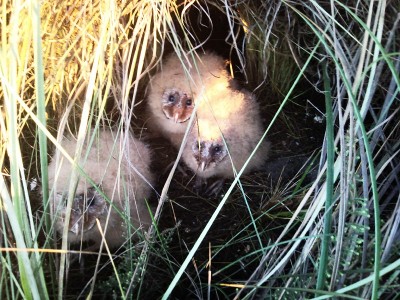
2) What are the closest relatives and how do they differ in behaviour and ecology?
The Eastern Grass-Owl Tyto longimembris, which occurs from India through China and south-east Asia to Australia, is considered by some authors to be conspecific with the African Grass-Owl, but in South Africa the Grass-Owl is most closely related to the Barn Owl Tyto alba. While there is some overlap in the habitat and prey (both feed primarily on rodents) of the two species, the Barn Owl is a high adaptable generalist able to exploit a diversity of natural and man-made environments including areas of intensive agriculture and urban sprawl provided that adequate prey and shelter are available. In sharp contrast, although populations of Grass-Owls may occasionally persist on the peri-urban fringe in areas where wetland roost habitat is protected from excessive burning, trampling and general disturbance, this species is far more dependant on natural landscapes than the Barn Owl. Both species hunt mainly at night using a low quartering flight and perches (the latter more so in the case of the Barn Owl probably because of relative availability of perches in their chosen habitats), but whereas Barn Owls may roost in a diversity of natural hollows, caves and crevices as well as in man-made structures during the day, Grass-Owls appear to roost almost exclusively in hollows in rank grass. While few who have visited an active Barn Owl territory at night can fail to have heard its characteristic drawn-out screech, the Grass-Owl appears to be considerably less vocal.
3) What is known about the current population of the African Grass Owl and how has the population changed over the last decades?
This is an area of research that urgently requires considerably more attention. Current population estimates for South Africa are at best little more than an educated guess and there appears to be even less information for the rest of their range. Good population data are only available from a handful of sites in South Africa and all surveys except for those in the Settlers area in Limpopo Province (surveyed in the late1970s) and Suikerbosrand Nature Reserve in Gauteng (surveyed annually since 2009) covered only relatively small areas.
Data from Suikerbosrand NR suggests that population fluctuations between years may be quite dramatic, something that should be expected in an ecosystem where rainfall, fire and grazing pressure can significantly affect cover and prey availability in the course of a single season. Of more immediate concern is the bird atlas data for South Africa (SABAP1 and SABAP2) which indicates an alarming decline in the Grass-Owl’s area of occupancy and reporting rates over the past 30 years or so over much of the species’ range. Data collected from various unpublished sources for the period between the two atlas projects gives some hope that the situation is not as dire as it might appear at first glance, but there can be little doubt that widespread land transformation and inappropriate management of large areas of remaining otherwise potentially suitable habitat have resulted in a population decline over the last few decades.
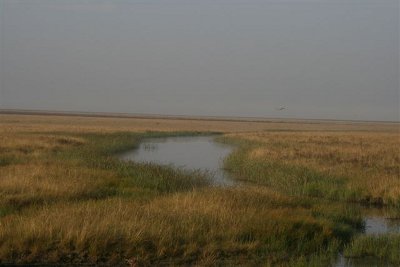
4) What is the main habitat of the African Grass Owl?
In the grassland biome the species typically roosts and breeds in tall rank grass or sedges in or adjacent to seasonal wetlands and along drainage lines foraging more widely over surrounding grasslands and agricultural fields. Elsewhere the species has been reported to utilize a diversity of vegetation types including open savanna with long grass, thorny bushveld, scrub, fynbos, renosterveld, bracken and even karroid vegetation though in most cases the chosen habitat was associated with a wetland of some sort.
5) What is the owl’s main food?
Rodents are the primary prey throughout their range, but shrews, bats, birds, frogs and invertebrates may feature in their diet to a lesser extent. I have yet to find frog or bat remains, but opening pellets can be surprisingly addictive so there is still a chance.
6) Does the African Grass Owl compete with other owl and raptors species for food and breeding places?
In the grassland biome, the breeding and foraging habitat of the more common Marsh Owl Asio capensis overlaps most closely with that of the Grass-Owl. Despite reports of aggressive interactions between the two species, they generally appear quite tolerant of each other and may nest/roost in relatively close proximity in the same wetland. While both species prey primarily on rodents, Marsh Owl pellets frequently include a much greater invertebrate component and when combined with their typically more diurnal activity pattern, foraging competition between the two species may be reduced to some extent. This is nevertheless and interesting topic for further research and Geoff Lockwood has begun looking into it.
The foraging habitat and prey of the African Marsh-Harrier Circus ranivorus also overlap with that of the Grass-Owl, and while the Marsh-Harrier has become rare in Gauteng, there is potential for competition elsewhere within their shared range.
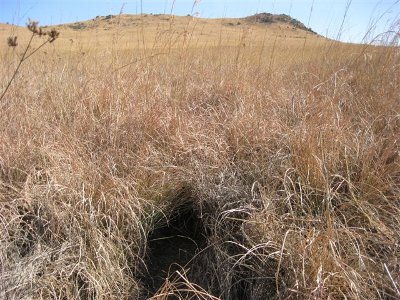
7) What are the natural enemies of the African Grass Owl?
As a ground-nesting species there is no shortage of potential predators during the breeding season. While nest failure due to predation appears relatively common (possibly as a result of a human observer creating a convenient path or scent trail to the nest site), the only recorded incidents of predation that I have encountered are by an African Marsh-Harrier on a juvenile/immature Grass-Owl at a roost and the killing of a female and her chicks by what appears to have been a Serval.
8 ) How does habitat destruction and a more intensive agriculture affect the African Grass Owl?
This is a very broad topic especially as the main drivers of habitat destruction vary across the range of the species. My experience lies mostly in the peri-urban environment where it appears that Grass-Owl populations may persist, at least over the short term, within a transformed landscape provided that adequate foraging and nesting/roost habitat remains available. Unfortunately we don’t yet have a good idea of the spatial requirements of the species and even where new urban developments attempt to plan for the inclusion of Grass-Owl habitat in an open space network, the area set aside often proves too small or is impossible to manage appropriately (e.g. fire is an essential tool for removing moribund material and preventing bush encroachment, but is a hazard in a built environment). In a fragmented landscape corridors to other suitable habitat patches are essential for population resilience, but these are designed in the absence of a good understanding of the owl’s dispersal requirements and are likely to become increasingly degraded and fragmented over time.
Mineral extraction is another major driver of habitat destruction since the global appetite for carbon fuels appears inexhaustible and short term economic gains invariably outweigh even the long-term strategic importance of wetland conservation let alone the conservation of owls. While South African legislation compels companies in the mining sector to rehabilitate areas affected by their operations, restoration of natural habitat and ecologically processes is more complex than simply re-vegetating the mine footprint.
Grazing and trampling of wetlands by livestock may be problematic for Grass-Owls where stocking densities are high, but if appropriate rotational grazing schemes are devised the loss of breeding and roosting habitat for owls need not be permanent. This should be an important focal area for agricultural extension officers. In some areas agricultural intensification effectively amounts to habitat destruction e.g. where range-land is converted into large-scale livestock rearing facilities (i.e. feedlots). While such changes may benefit the Barn Owl, Grass-Owls are likely to loose foraging habitat.
Grass-Owls may occur at relatively high densities in areas of intensive crop production provided that breeding and roosting habitat is protected from ploughing, but even where this is the case the wetlands are rarely adequately buffered and degradation as a result of increased nutrient run-off and invasion by weeds seems inevitable. Intensive subsistence agriculture in wetland areas appears to be an increasing problem in-and-around major urban centres in southern Africa where little alternative open land may remain and Grass-Owls are inevitably displaced as a result.
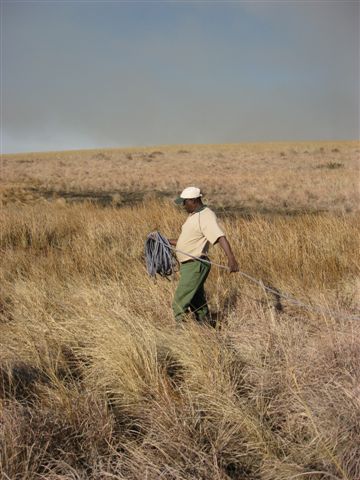
9) Is electrocution a problem for the owls?
I know of one incident of a Grass-Owl colliding with a powerline, but no electrocution incidents have been reported to me.
10) What other threats do exist for the species?
Roadkills and entanglement on barbed wire fences appear to be the biggest threats after habitat loss and degradation.
11) What gaps in the knowledge about the African Grass Owls do still exist and where should research focus on in the coming years?
The rarity and nocturnal nature of Grass-Owls means that they are relatively challenging to study and as a result we are lacking information on some very fundamental aspects of their biology for example we don’t know what their spatial requirements are, we don’t know why they are present in an area in one year and not the next despite no obvious change in the habitat quality, we don’t know much about their dispersal abilities either in natural or fragmented lanscapes or how readily they re-colonize areas after a disturbance (e.g. fire).
Establishing the foraging requirements of the Grass-Owl is critical for effective conservation planning in areas that are threatened by habitat destruction whether caused by urbanization, mining or some other factor. However, since most Grass-Owls occur in rural areas we also need to determine the appropriate use of fire and grazing as habitat management tools in each biome and develop practical extension tools for use by commercial and subsistence farmers. Further research is also required into road design and maintenance in order to reduce roadkills.
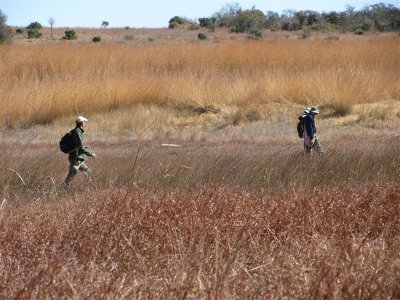
12) Are there any conservation programs for the species?
In the 2009 the then Bird of Prey Working Group of the Endangered Wildlife Trust established the African Grass-Owl Task Force. This task force comprises Grass-Owl enthusiasts from a diversity of fields and draws on their expertise to conduct research, gather information and create awareness in order to further conservation of the species. Examples of such initiatives include ongoing research into the spatial requirements of the Grass-Owl, targeted surveys and gathering of historical data in order to map Grass-Owl distribution for inclusion in provincial conservation plans, and the collection of roadkill data for the identification of mortality ‘hotspots’. To date the focus has been on southern Africa, but participation from elsewhere in the species’ range would be welcomed.
13) What other species of birds and other animals could benefit from such conservation programs?
Habitat conservation is a critical component of the task forces’ work and the identification and conservation of wetlands and associated terrestrial foraging habitat and corridors that are of a suitable size and managed appropriately to ensure the persistence of Grass-Owls will benefit a diverse suit of species that are dependant on similar habitat including the African Marsh Harrier, Serval, Giant Bullfrogs and many other rare and common species.
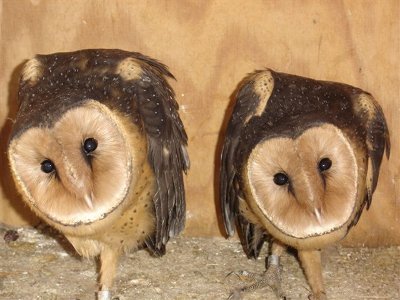
14) How do you see the future of the African Grass Owl?
For various reasons I don’t hold much hope for the persistence of those Grass-Owl populations in peri-urban areas, but there is room for optimism elsewhere:
1. Regional spatial conservation plans are available for much of the species’ range in South Africa; 2. All levels of government are becoming increasingly aware of the importance of wetland conservation in a water scarce country; 3. Landowners that I have encountered are generally positive about conservation of biodiversity and would probably be receptive to advice on habitat management provided that the realities of their need to make a living from the land were recognized.
15) What was your most amazing experience with the African Grass Owl?
While I feel I should be describing my first Grass-Owl sighting (equally unexpected for me and the owl) or my first discovery of a nest full of downy chicks, the most amazing experience has actually been the response from volunteers. These are not mere twitchers keen for a lead on a tricky tick, but well known names in the raptor and conservation world as well many other less renown but equally dedicated enthusiasts who have generously shared their knowledge and experience and repeatedly donated their time to facilitate and promote research and conservation of the species.

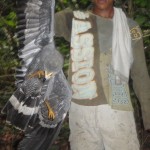
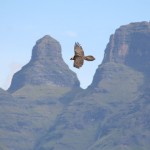

A most interesting article ! It’s a great pity that i’m no longer resident in Zimbabwe as we had them breeding, along with Marsh Owls in the vlei on CORNWALL FARM, MARONDERA NORTH. You’d have been very welcome to have carried out any research there, but I guess that now you would not be welcome due the the presence of “undesirables”!!!!!!
What an interesting and informative article.
As a member of Birdlife Harties it seems that two sightings were made near Hartebeespoort dam. One in the Xanado estate (eastern side of the dam) and another along the Crocodile river at the upstream side of the dam.
It is possible that there are more birds around than what we expected.
Thanks for a very nice article, Frans.